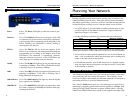
Planning Your Network
Building a Gigabit network involves more topology rules in addition to the
10BaseT/100BaseT network rules. These rules specify distance limitations
and cabling specifications. Data loss, collisions, and other network problems
causing down time are likely to occur if the rules below are not followed.
• Use UTP Category 5 (or better) Ethernet cabling with four pairs of wires
and RJ-45 tips for all Fast Ethernet connections. Gigabit connections
should use Category 5e (or better).
• Use the chart below to position your switches, hubs and workstations.
*Hub refers to any type of 100Mbps hub, including regular hubs and stackable hubs. A
10Mbps hub connected to another 10Mbps hub can span up to 100 meters (328 feet).
• No more than two hubs should be uplinked in a row in a Fast Ethernet net-
work. A set of stacked hubs, which must be stacked with a stacking cable,
counts as one hub or node on the network.
• In Fast Ethernet networks, your 10/100 Switch acts as a repeater, regener-
ating data signals before passing them on to the next device. Passive hubs
do not function as repeaters.
Your Workgroup GigaSwitch boosts your network performance several times
over, conserving your time, money and resources. The scalability of your
Switch, its full duplex data transfer and dedicated bandwidth all contribute to
maximizing efficiency in your Fast Ethernet network.
Your Switch’s 10/100 feature gives you a key advantage over other forms of
networking by upgrading speed-critical network segments to 100Mbps while
allowing existing 10BaseT networks to operate with the Switch. Allowing
10BaseT and 100BaseTX hardware speeds to run alongside each other elimi-
From
Switch
Hub*
Switch or Hub
Switch or Hub*
Hub*
Workstation 1
Maximum Distance
100 meters (328 feet) 1
5 meters (16.4 feet) 1
100 meters (328 feet) 1
To
Overview
Switches Versus Hubs
EtherFast
®
10/100/1000 8+1 Workgroup GigaSwitch
The LED Indicators
Power Amber. The Power LED lights up when the Switch is pow-
ered on.
Link/Act Green. The Link/Act LED serves two purposes. If the LED
is continuously lit up, the Switch is successfully connected to
a device through the corresponding port (1 through 8). If the
LED is flickering, the GigaSwitch is actively sending or
receiving data over that port.
FD/Col Green. The FD/Col LED also serves two purposes. If this
LED is lit up continuously, the connection made through the
corresponding port is running in Full Duplex mode. If the
LED flickers, the connection is experiencing collisions.
Infrequent collisions are normal. If this LED flickers too
often, there may be a problem with your network.
10/100 Amber. The 10/100 LED lights up for any port when that port
is operating at 100Mbps. If the LED is off while the network
is operating, the port is operating at 10Mbps.
1000 Amber. The 1000 LED lights up when the Gigaswitch port is
operating at 1000Mbps. If the LED is flickering, data is
being transmitted through the port.
1000 Link/Act Green. The 1000 Link/Act LED lights up when the Gigabit
port is operating at 1000Mbps.
1000 FD/Col Green. The 1000 FD/Col LED lights up continuously when
the switch is operating at 2000Mbps and flickers when expe-
riencing data collisions.
The 10/100/1000 Workgroup GigaSwitch’s Front Panel
Instant Gigabit Series
4 5














